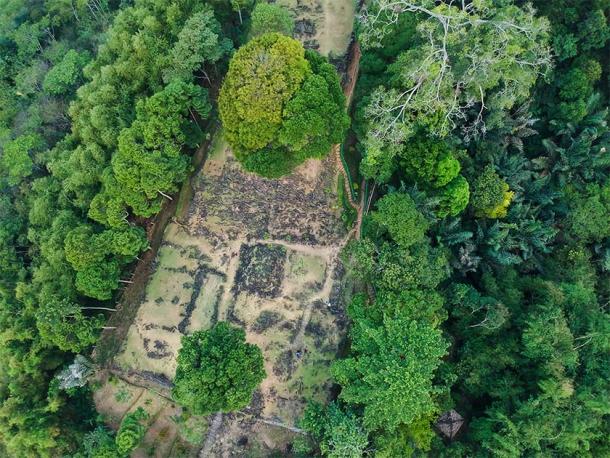A 27,000-year-old Indonesian pyramid’s new claims ignite a debate.

A controversial paper recently published in the journal Archaeological Prospection has generated debate and criticism from archaeologists and geologists alike. In this newly completed study, a team of Indonesian researchers argues that a series of buried rock formations at the prehistoric megalithic site of Gunung Padang in West Java are actually a large, man-made Indonesian pyramid that was constructed in stages starting as long as 27,000 years ago.
These claims are not new. Although new evidence has been brought forward to back the claim, including dating tests, this thesis has been—perhaps unsurprisingly—forcefully rejected by the mainstream scientific community. For it seems that they refute the notion that a pyramid-building society would have existed in Indonesia or anywhere else before the end of the last Ice Age in 10,000 BC.
In the newly published article, the Indonesian researchers present their thesis that four layers of megalithic stone structures were built over the course of many thousands of years. This was done on top of the defunct and decayed volcano known as Gunung Padang, which is located in West Java’s rocky and hilly countryside.
The research team was led by Dr. Danny Hilman Natawidjaja from Indonesia’s Research Center for Natural Disasters, National Research and Innovation Agency (BRIN). Proving that the stone formations at Gunung Padang were built by a long-lost Ice Age civilization has been a long-time obsession for Dr. Natawidjaja. In the process, his efforts have made him a lightning rod for criticism from academics who dismiss his ideas out of hand.

The seemingly hand carved rocks at Gunung Padang, in West Java (RaiyaniM / CC BY-SA 4.0)
The Indonesian Pyramid Builders of Gunung Padang?
There is no dispute that the top two layers at Gunung Padang include rock columns, walls, pathways and spaces that were intentionally constructed. But the accepted belief is that the deeper “structures” are not the foundation of an Indonesian pyramid, but natural rock formations created by past volcanic activity and untouched by human hands.
If the alternative hypothesis is correct, it would mean there were builders working with heavy stones in Indonesia long before there were any in Egypt, where the 4,600-year-old Pyramid of Djoser stands as the country’s oldest. If they existed, these Indonesian pyramids would have predated even the monumental construction experts responsible for creating the world’s oldest known megalithic structures at Göbekli Tepe in Turkey, in approximately 9,000 BC.
“The pyramid has become a symbol of advanced civilization,” Dr. Natawidjaja said in an article about his controversial study just published by Nature. “It’s not easy to build pyramids. You need high masonry skills.”
The latter observation is correct and a main point of dispute, as other Indonesian researchers (and scientists from other nations as well) are quick to point out when discussing the Indonesian pyramid hypothesis.
Dr. Lutfi Yondri, an archaeologist and Dr. Natawidjaja’s colleague at BRIN, notes that his research shows that people only inhabited caves in the West Java region between 12,000 and 6,000 years ago. Yondri also argues that no evidence has ever emerged suggesting these people possessed advanced masonry skills.
Dr. Yondri’s dismissive attitude to his colleague’s ideas is shared by most Indonesian archaeologists and geologists. When it comes to the subject of Indonesian pyramids, they have taken the extraordinary step of circulating a petition decrying Dr. Natawidjaja’s research and government support for it back in 2018.
The international rejection of the newest version of Dr. Natawidjaja’s thesis has been just as vehement as the local opposition. “I’m surprised [the paper] was published as is,” stated Dr. Flint Dibble, an archaeologist at Cardiff University in the UK.
While acknowledging the paper presented some legitimately intriguing data, he was firm in his insistence that the study’s conclusions in relation to the supposed Indonesian pyramid are not supported by the bulk of the evidence. This assertion is echoed by many other scientists, who simply can’t conceive of how monumental stone builders could have been found in Indonesia in 25,000 BC.

Gunung Padang is the largest megalithic site in all of Southeastern Asia. Could it really have been home to an Indonesian pyramid? (adelukmanulhakim / Adobe Stock)
The Indonesian Pyramid Theory is Making Waves
Perched on top of an ancient volcano, Gunung Padang consists of five stepped stone terraces, retaining walls and connecting staircases. Between 2011 and 2014 Dr. Natawidjaja and his colleagues used ground-penetrating radar and carbon-dating techniques to identify four distinct rock formation layers at the site, all of which they believe show signs of human modification. The innermost layer is made from hardened lava, which the researchers claim has been “meticulously sculpted.”
Summarizing all the research they’ve completed of the supposed Indonesian pyramid over the past decade-plus, in their paper in Archaeological Prospection Dr. Natawidjaja and his team state their conclusions thusly:
“This study strongly suggests that Gunung Padang is not a natural hill but a pyramid-like construction. The pyramid’s core consists of meticulously sculpted massive andesite lava (Unit 4), enveloped by layers of rock constructions (Unit 3, Unit 2 and Unit 1). The carbon dating analysis further supports the multi-layer construction’s long history, spanning successive periods.
The oldest construction, Unit 4, likely originated as a natural lava hill before being sculpted and then architecturally enveloped during the last glacial period between 25 000 and 14 000 BCE. Afterward, Gunung Padang was abandoned by the first builders for thousands of years, leading to significant weathering. Around 7900–6100 BCE, Unit 3 was deliberately buried with substantial soil fills. Approximately a millennium later, between 6000 and 5500 BCE, a subsequent builder arrived at Gunung Padang and constructed Unit 2. Lastly, the final builder arrived between 2000 and 1100 BCE, constructing Unit 1.”
Dr. Natawidjaja and his colleagues first made their case for the artificial nature of the rock formations at Gunung Padang during the annual meeting of the American Geophysical Union in Washington, D.C. in 2018. Their claims of having found an Indonesian pyramid were greeted with intense skepticism at that time. Meanwhile, the feelings of the archaeological establishment in Indonesia and elsewhere have not changed in the years since.
Commenting on the new paper, Dr. Dibble stated that there is no clear evidence that buried rock formations were constructed by humans. Dibble claimed they were more likely to have come about because of erosion and rock movements over time. “Material rolling down a hill is going to, on average, orient itself,” he told Nature.
But Natawidjaja counters that the column-shaped stones were too large and precisely arranged to have arrived in their present locations through such a process. “The neatly arranged, shaped and massive nature of these rocks, some weighing up to 300 kilograms [661 lbs], dismisses the likelihood of transportation over significant distances,” he said.
Beyond the dispute over whether buried rock “structures” that seem geometrical could arise through natural forces, there is also the fact that the current model of the rise of civilization doesn’t fit Dr. Natawidjaja’s theories.
Dr. Bill Farley, an archaeologist at Southern Connecticut State University in New Haven, says the new study fails to provide evidence that any type of advanced civilization existed during the last Ice Age. Archaeological records suggest that only hunter-gatherer societies existed before 12,000 years ago, and without any artifacts from earlier times Dr. Farley rejects the idea that the alleged pyramidal structure at Gunung Padang can be attributed to an ancient culture.
The many seemingly manmade rocks at Gunung Padang are explained as naturally occurring formations by geologists. (uskarp2 / Adobe Stock)
Indonesian Pyramid Controversy: Punishment for Scientific Heresy?
Apparently in response to the controversy, the publisher of Archaeological Prospection, Wiley, has just announced it will be conducting an investigation of Dr. Natawidjaja’s team’s work. “The editors, including me, and the Wiley ethics team are currently investigating this paper in accordance with Committee on Publication Ethics guidelines,” stated Eileen Ernenwein, an archaeological geophysicist at Tennessee State University who co-edits Archaeological Prospection.
Dr. Ernenwein did not reveal what concerns she thinks might justify this type of investigation, which is troubling. While archaeologists who believe the buried formations at Gunung Padang are natural do have the current scientific consensus on their side, it isn’t at all clear why Wiley has chosen to launch a probe into the composition and publishing of an article that presents an alternative hypothesis, even when it does posit the existence of Indonesian pyramids.
The open-minded presentation of controversial theories, or even outright advocacy for them, doesn’t automatically represent some type of ethical breach that needs to be investigated. In reality, science is supposed to welcome challenges from “outsiders” and mavericks with alternative hypotheses, and counter them exclusively with factual knowledge rather than personal or professional attacks that question the integrity of the dissenters.
Maverick theorists could just as easily question the motives of those whose livelihoods or reputations rely on the preservation of the status quo. In the end everyone’s beliefs could be attacked or dismissed if such an approach is taken to its logical conclusion.
It should be noted that despite the controversy generated by claims of an Indonesian pyramid, Dr. Danny Hilman Natawidjaja possesses impeccable credentials. He received his PhD from the prestigious California Institute of Technology (CalTech), served as the senior geologist at the Indonesian Center for Geotechnical Research, and has been a member in good standing at the Indonesia Institute of Sciences.
“We are really open to anyone researchers around the world would like to come to Indonesia and do some research on Gunung Padang,” Dr. Natawidjaja told Nature, highlighting his preference to work with the scientific community instead of being at odds with it. “We know very little about our human history.”